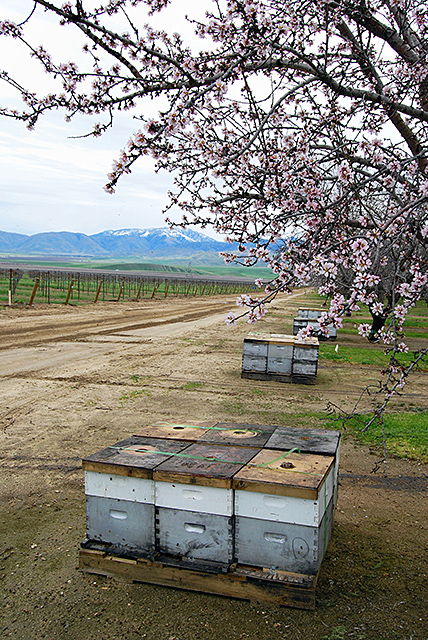
Jonah Vu
Intern, Frontier Group
Bees are essential to agriculture. But the way we grow food is putting bees at risk. Moving away from monoculture farming can be part of the solution.
Intern, Frontier Group
Senior Director, Conservation America Campaign, Environment America Research & Policy Center
Food & Agriculture, Advocate, U.S. PIRG Education Fund
Bees are essential to agriculture. Without pollinators, a variety of crops, such as almonds, mangoes, tomatoes, peaches, coffee, chocolate and many, many more, would not grow.
We need bees, but their populations are shrinking due to increasing colony collapse. Between April of 2022 and 2023, beekeepers nationwide reported losing 48% of their colonies – a rate that was among the highest on record and more than 8 percentage points higher than the average loss rate over the previous 12 years. This statistic reflects the massive bee population decline of the 21st century, which is detrimental to the animals that pollinate one out of every three bites of food.
The collapse of bee colonies can be attributed to several factors, including pesticide use, global climate change, parasites and modern farming practices. Human activities have negatively impacted many pollinator habitats, notably in agricultural lands, where bees depend on crops to sustain themselves. Among the activities that are depriving bees of the sustainable, varied food sources they need to survive is the widespread adoption of monoculture farming. If we want to ensure healthy populations of bees, we need to take a hard look at how we grow our food.
Monoculture farming involves the cultivation of a single crop, replanted year after year, over an extended area. This method gained popularity with the agricultural revolution of the 20th century, in which consolidated large-scale farms outcompeted smaller, traditional and diversified farms.
As a result, monoculture practices are now common; in a drive across the Midwest or California’s Central Valley, one can see huge swaths of land dedicated solely to soybeans, corn, wheat, fruit trees or other crops. Because monoculture farming reduces the resources and knowledge needed to farm, the practice is often more profitable and more efficient. However, the practice comes with multiple negative environmental consequences.
Monoculture practices threaten the biodiversity of an area; this presents multiple issues for bee populations, which depend on balanced diets that are unsatisfied by a single type of food.
The lack of diversity in their diets contributes to poor nutrition, which weakens their immune systems and makes them vulnerable to harm from viruses and diseases. Pesticide use and nutrient-deficient habitat – both features of monoculture farming – are known to lead directly to bee colony collapse.

Bee boxes with honey bee colonies placed at the edge of an almond orchard and next to another monoculture planting.Photo by Jeff Pettis, USDA Agricultural Research Service | Public Domain
All of this is bad enough. But committing to monoculture farming creates a downward spiral that magnifies the damage to pollinators over time, and requires farmers to go to ever-greater lengths to pollinate their crops.
For starters, monoculture farming degrades soil quality, necessitating stronger fertilizers. Lack of plant diversity also allows mites and crop-eating insects to develop resistance to insecticides, encouraging farmers to use stronger and stronger pesticides.
When these farms inevitably use more and stronger chemicals to combat soil degradation and pest immunity, bees suffer. With immune systems already weakened by lack of diversity in their diet, their populations find it more difficult to survive against more and stronger chemicals.
And, as the soil at monoculture farms continues to decline in fertility, more artificial fertilizers are needed, and the cycle continues to spiral downward.
The result of this is an unsustainable ecosystem, partially illustrated by the bee population decline. With monoculture farming areas unable to sustain healthy populations of pollinators on their own, it has become customary for bees to be exported to farms across the country, with colonies being transported over 2,000 miles to pollinate crops. The ordeal causes bees stress and sometimes even colony collapse, and is little more than a band-aid solution to a worsening problem.
Given the nature of monoculture agriculture and its unsustainability, it is necessary that farmers adopt better practices that protect bees and allow them to thrive. Monoculture agriculture, while both financially and logistically attractive in the short term, needs to be reformed to ensure it does not continue to accelerate the decline of bee populations.
The alternative to planting one type of crop on a piece of farmland is to plant several of them, a practice known as polyculture. There are various methods of accomplishing polyculture, such as raising multiple different crops within the same growing season by harvesting and replanting quickly (multicropping), or mixing two or more crops during a single season (intercropping).
These strategies, and the diversification of crops in general, have been shown to improve soil health, thereby lessening the need for synthetic fertilizers, as well as aid in pest management, decreasing the necessity for strong chemical pesticides that inhibit pest insects. Both impacts can reduce the harm to pollinator populations while, of course, also providing them with a more diversified diet.
Diverse food sources not only increase pollinator health, but are also more likely to attract multiple species of bees, increasing the biodiversity of these agricultural ecosystem to support a healthy array of pollinators.
There are also other farming methods that can increase biodiversity and support pollinators.
Cover cropping involves planting beneficial, non-marketable plants either next to agricultural land or, during the off-season, within it to encourage soil health and attract pollinators. Similarly, hedgerows border pieces of farmland and can also incorporate native plants and shade trees that provide needed diversity for bees.
These strips of vegetation not only improve soil health and attract pollinators, but they also protect farms from wind and dust, while additionally acting as carbon storage that slows the release of carbon dioxide into the atmosphere.
The benefits from diversifying the food available to pollinators are many, and so are the methods for doing so. With bee populations in decline, it is necessary to move towards different forms of agriculture that promote and foster biodiversity – actions that have positive rippling effects for the environment. The food we eat is dependent on pollinators, and their welfare and protection is essential for our future.
Intern, Frontier Group
Senior Director, Conservation America Campaign, Environment America Research & Policy Center
Started on staff: 1991 B.A., Wartburg College Steve directs Environment America’s efforts to protect our public lands and waters and the species that depend on them. He led our successful campaign to win full and permanent funding for our nation’s best conservation and recreation program, the Land and Water Conservation Fund. He previously oversaw U.S. PIRG’s public health campaigns. Steve lives in Sacramento, California, with his family, where he enjoys biking and exploring Northern California.
Danielle works to ensure our food system produces enough nutritious food to feed everyone, without threatening our health, the planet, or the ability of future generations to grow food. Danielle lives in Chicago, where she enjoys staying active in the outdoors, trying out new recipes, and writing short stories.
